















11-12 October 2025
Cannes, France
13-16 October 2025
Cannes, France
18-21 November 2025
Cancun, Mexico
February 2026
London, United Kingdom
We are pleased to present this special issue at a pivotal moment for India’s media and entertainment (M&E) sector, which is experiencing a transformative shift driven by unprecedented technological innovation and evolving business models. As artificial intelligence and digital disruption redefine the ways we create, distribute, and consume content, our industry is uniquely positioned to lead in this era of innovation.
In this edition, we feature exclusive insights from Gaurav Banerjee, Chairman of the CII National Media and Entertainment Council, in a thought-provoking interview that examines the path forward. We also introduce the new members of the Council, whose combined expertise will guide the sector through its next phase of growth. Additionally, we commemorate a significant cultural milestone with a preview of the 50th Toronto International Film Festival, which celebrates half a century of cinematic excellence.
The numbers tell a compelling story. India’s M&E sector, growing at a robust 10–12% annually to reach around US $30 billion, has become an important contributor to the global value chain. With the right strategic interventions, the industry can achieve the ambitious US $100 billion milestone within this decade—a vision CII champions through collaboration and innovation-led growth.
AI and emerging technologies are no longer mere enablers; they are now the primary catalysts driving industry evolution. From hyper-
personalised streaming experiences to AIpowered content creation tools, the shift is both rapid and profound. This transformation calls for a reimagining of traditional business models while preserving the cultural authenticity that has always defined Indian storytelling.
Our strategy for achieving the $100 billion goal is built upon four key pillars:
• Skilling and education, aimed at equipping talent with both creative and technological expertise.
• Robust copyright protection and anti-piracy measures to ensure the safeguarding of intellectual property.
• Progressive regulatory reforms that promote innovation while maintaining the integrity of content.
• Innovation as a catalyst for economic growth—creating jobs, nurturing startups, and enhancing global outreach.
The opportunity before us is vast. By embracing innovation while remaining faithful to our cultural roots, India can transform from being one of the world’s largest consumers of content into a global powerhouse in the content industry.

This is our moment to craft the next chapter in India’s entertainment narrative—one that will resonate across the globe.
If you have any questions, or are interested in collaboration opportunities, don’t hesitate to get in touch.
n vidyasagar pickle media nat@pickle.co.in, www.pickle.co.in
Published by Pickle Media Private Limited
Email: natvid@gmail.com
l Mumbai l Chennai No.2, Habib Complex
Dr Durgabhai Deshmukh Road
RA Puram CHENNAI 600 028
For advertising: natvid@gmail.com / pickle@pickle.co.in
Pickle Business Guide 2025 Copyright 2025 by
Pickle Media Pvt Ltd. All Rights Reserved.
Senior Editor : Vivek Ratnakar
Editorial Coordinators : Maitreyi Vidyasagar, Shruti Sundaranand
Design: Jose J Reegan, James, D Sharma, S Lakshmanan
Photo Editor : K K Laskar
Admin & Operations : B Rajalakshmi
Email: natvid@gmail.com
Pickle is an ad supported business guide tracking the filmed entertainment business in India.




















































































LOS ANGELES I NOVEMBER 11-16, 2025
India’s media & entertainment market is racing ahead at 7.5% CAGR, fuelled by a digital ad boom, gaming, and OTT growth—positioning the nation as a key driver of the US $3.5 trillion global industry by 2029
India is rapidly establishing itself as one of the fastest-growing media & entertainment (M&E) markets in the world, setting the pace for an industry on track to touch US $3.5 trillion by 2029. With an annual growth rate exceeding 7.5%, the country’s expansion is fuelled by an internet advertising boom— soaring at 15.9% annually—driven by deepening internet penetration, the rapid rollout of 5G services, and the meteoric rise of social media and shortform video content.
According to PwC’s latest Global Entertainment & Media Outlook 2025–2029, India sits alongside Indonesia and Saudi Arabia as one of the most dynamic markets worldwide. YouTube alone paid Indian creators US $2.8 billion in 2024, with another 30% jump expected this year. Data consumption is set to skyrocket, reaching nearly one million petabytes by 2027, underscoring the market’s appetite for digital experiences.
While subscription-based services face headwinds from market saturation and cautious household budgets, advertising has taken centre stage as the M&E sector’s primary growth engine. Globally,

advertising revenues are expected to grow at a robust 6.1% compound annual rate through 2029—three times faster than consumer spending, which is forecast at just 2%.
By the end of the forecast period, advertising is projected to outpace consumer spending by US $300 billion, a shift that became evident in 2024. Digital formats are driving this transformation, with their share of ad revenues rising from 72% in 2024 to 80% in 2029. Key high-growth categories include retail advertising and social and mobile onstream video advertising, both expanding at around 15% annually.
Connected TV epitomises the sector’s evolution. Its advertising revenue, once a mere 5.9% of broadcast TV advertising in 2020, is on track to reach US $51 billion by 2029—equal to 45% of traditional TV ad spend. This leap is being supercharged by artificial intelligence and hyperpersonalisation, enabling highly targeted and efficient campaigns.
The report flags video games as a cornerstone of modern entertainment. Global gaming revenues are projected to climb from US $223.8 billion in 2024 to nearly US $300 billion in 2029, growing at a 5.7% CAGR. Advertising within games is becoming a lucrative frontier, rising from 32.3% of sector revenue in 2024 to 38.5% in 2029.
OTT video is another bright spot, projected to grow from US $169 billion in 2024 to US $230 billion by 2029. Advertising-based video-on-demand (AVOD) will account for more than a quarter of this market, reflecting a wider consumer shift toward ad-supported streaming models.
Despite the surging tide of digital consumption, non-digital formats still account for more than 60% of global consumer M&E spending. Live events, cinema outings, and physical media continue to command significant loyalty, showing that audiences still value shared, offline entertainment.
While the global M&E market grew to nearly US $3 trillion in 2024 and will rise at 3.7% annually to 2029, India’s momentum stands out. In contrast, the US market is projected to grow at 3.8% (excluding connectivity), and China’s at 6.1%.
Cinema is also rebounding, with global box office revenues set to grow from US $33 billion in 2024 to US $41.5 billion by 2029. Audiences are increasingly favouring local productions over Hollywood blockbusters—the top five US studios’ global market share has fallen from more than 60% pre-pandemic to 51% in 2024. In India, this preference aligns with the success of regional cinema and locally resonant storytelling.
The industry’s evolution is inseparable from advances in technology. In 2024 alone, more than US $56 billion was invested in generative AI businesses, with applications ranging from advertising optimisation to automated content creation. AI-driven hyperpersonalisation is expected to further accelerate digital advertising uptake, especially in connected TV and social platforms.
For India, the coming years will be defined by its ability to harness its scale, digital adoption, and creative talent to lead not just in content consumption, but in content creation and innovation. As the country’s entertainment and media footprint expands, it will not only contribute to, but also help define, the shape of the US $3.5 trillion global industry of 2029.
India’s Media and Entertainment sector is poised for a creative renaissance, fuelled by government support and strategic initiatives like the Indian Institute of Creative Technologies (IICT), new emerging technologies and AI disruption.With a booming digital landscape and a goal of reaching $100 billion by 2030, the country is set to become a global powerhouse in content creation. By Chandrajit Banerjee, DG, CII
As we stand on the brink of a new era, the Indian Media and Entertainment (M&E) industry is poised for an extraordinary transformation. With strategic government support, collaborative industry efforts, and a steadfast belief in the mantra of “Create in India for the World,” the sector is set to experience unprecedented growth. The year 2025 represents a turning point for the sector, which is symbolised
by initiatives such as the WAVES Summit and the founding of the Indian Institute of Creative Technologies (IICT) in Mumbai. CII is one of the industry stakeholders in the formation of IICT with the Government of India.
The IICT is a significant step forward for the industry, since it is modelled after the IITs and IIMs. The next generation of world-class M&E professionals will be trained by this institution, which will enable India
to become a truly global powerhouse for media, gaming, animation, music, and emerging technologies. This institution will be supported by significant industry engagement and relationships with global tech giants.
The time has come to act. Currently, we are experiencing the “India Opportunity” in its purest form, with the creative economy of India gaining tremendous traction on a global scale. One of the
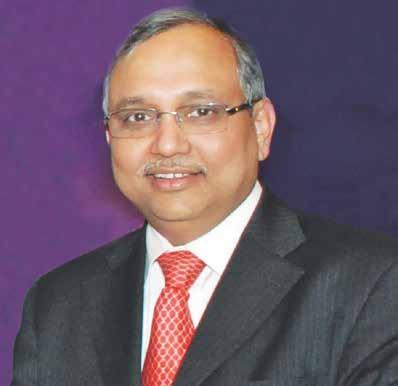
highest digital adoption rates in the world and a growing population that is hungry for content are both contributing factors that are causing the $30-billion industry to undergo fast transformation.
The number of people using the internet in India exceeds 800 million, with mobile devices accounting for 75% of the traffic. Over eighty percent of mobile usage is devoted to the consumption of content, and by the year 2024, digital media has surpassed television to become the most lucrative section of media and entertainment,
Chandrajit Banerjee Director General Confederation of Indian Industry
accounting for thirty-two percent of total profits.
This forward momentum is the result of a number of factors, including favourable demographics, which include 910 million users who are members of the millennial and Gen Z generations, rising income, cultural richness, and a huge cost advantage in producing content of world-class quality. Due to the fact that Indians spend 82% of their screen time on entertainment and media apps, we are not merely consumers; rather, we are creators and curators of digital
WE BELIEVE THAT THIS DECADE BELONGS TO INDIA’S STORYTELLERS, TECHNOLOGISTS, AND CREATIVE ENTREPRENEURS. TOGETHER, WE CAN BUILD A KNOWLEDGE-DRIVEN ENTERTAINMENT ECONOMY THAT RESONATES ACROSS THE WORLD
content from around the world.
The CII has set an ambitious target, which is to develop Indian M&E into a $100 billion industry by the year 2030. It is not only a goal to strive for; it is a goal that can be accomplished. Recent research suggests that India’s Media and Entertainment sector is among the fastest expanding in the world. It will fuel economic growth, generate large-scale employment, and amplify India’s soft power through cultural diplomacy.
To get there, we must remain focused. We need sustained investment in creative infrastructure, next-gen production facilities, and a sharper focus on creative tech education and skilling. It will be vital to implement policy reforms that will promote innovation, streamline processes, and strengthen collaboration between the government and their respective industries.
The government’s recognition of M&E as a sunrise sector, coupled with the visionary leadership, has created the right foundation. Now, it’s time to scale. With a focus on collaboration and a disruptive energy, India’s M&E sector is well positioned to reshape the global creative leadership.
We believe that this decade belongs to India’s storytellers, technologists, and creative entrepreneurs. Together, we can build a knowledge-driven entertainment economy that resonates across the world. This will not only make the dream of $100 billion a reality, but it will also make it inevitable.

Gaurav Banerjee, Chairman of the CII National Media and Entertainment Council and CEO & MD of Sony Pictures Networks India
Gaurav Banerjee, the Chairman of the CII National Media and Entertainment Council and CEO & MD of Sony Pictures Networks India shares why India’s creative economy must become a global force, how the government and industry can collaborate to accelerate this transformation, and why the next decade will be defined by those who can combine ambition with execution. Gaurav Banerjee chats with Pickle
India’s media and entertainment (M&E) industry stands at a critical inflection point— one shaped by geopolitical shifts, rapid technological disruption, and the unstoppable rise of artificial intelligence. Yet, amidst this churn, Gaurav Banerjee, Chairman of the CII National Media and Entertainment Council and CEO & MD of Sony Pictures Networks India, sees opportunity rather than uncertainty.
In this candid interview, he shares how this can be India’s moment if we invest in talent, embrace technology, and dream globally.
The industry is at the cusp of major changes globally and in India. What are the two or three key issues that you believe the industry needs to focus on immediately? As a leader, how do you envision addressing these challenges?
I think that the industry and the world at large are experiencing a period of significant change. Changes are occurring due to various geopolitical factors, and we find ourselves in an era marked by trade wars.
Furthermore, changes are driven by the rapid pace of technological advancement, particularly with the revolution in artificial intelligence. In a world that is in such flux because of these political and technological transformations, we require a framework and method to discuss and develop new ways of working to effectively drive growth.
In our country, the media and entertainment industry has two major ways it can contribute. As the industry shapes culture and defines the national mood, it can act as a force multiplier and determine the society’s direction.
Secondly, a thriving industry can also provide meaningful employment in areas that enrich our lives, particularly through cultural narratives and stories.
For these reasons, it is essential that we cultivate a thriving ecosystem. As
India emerges as one of the largest economies in the world, it is time for our stories to gain a significant global presence.
I believe this is an ambitious goal that everyone can and should unite to pursue with sincere effort.
Given the ambition you have set and the group of leaders who will be working alongside you, how can we bring all these people together to make this framework a reality?
I believe we need to engage in extensive dialogue to determine our priorities and necessary actions. First and foremost, we must strengthen the creative economy of our country across all its dimensions. This begins with the dialogue on what steps can we take to build the appropriate ecosystem, train talent, and make this ecosystem more accessible to emerging artists. We need to explore ways to significantly enhance the Centres of Excellence for learning that we currently have.
We must establish a strategy to expand the market for the products we create, beginning within our own country and, more importantly, extending globally. For instance, if we recognise a promising new studio, that studio should be capable of producing stories that resonate not only in India but also throughout Asia and beyond.
In today’s world, content distribution is inherently global, and significant advancements have occurred as content has started to be disseminated at scale via the internet. Therefore, we are no longer constrained by issues such as language, geography, or nationality; these factors have become less important.
ONE OF OUR MOST POWERFUL EXPORTS
Consequently, an impressive global marketplace of ideas has emerged, and we have witnessed remarkable content from countries like Israel and Korea that has truly captured global imagination.
There is no reason why similar success should not occur from here. Recent films such as RRR and prior
to that, Bahubali, have demonstrated the immense potential of Indian stories beyond our borders. However, for 1.4 billion Indians, this should not be an isolated occurrence. It should happen much more frequently and at a larger scale. Only then will this market and its revenue potential become truly attractive and meaningful.
Economic pressures are ever present, and there is a push for “behind the scenes” value rather than only glamorous appeal. How should the industry handle these economic challenges?
I believe that in the entertainment industry, the majority of funding should go to the talent. Given that we are a cricket-obsessed nation, it is only fair that exceptional cricketers, who are achieving remarkable feats on the field, receive the compensation they deserve. However, the challenge for us is to ensure that this also occurs in other sports and in the entertainment sector.
I also believe that we need to work towards creating an environment that is as supportive and vibrant for other sports as it currently is for cricket in our country. The establishment of the IPL has transformed the landscape; rather than just one Indian team, we now have a remarkable Indian team alongside ten strong IPL teams.
Additionally, we have developed a feeder system into the IPL, with T20 leagues across various states where
new players can emerge. Those who perform well in the IPL can subsequently be selected for the Indian team. This has led to the establishment of serious and committed cricket academies, where young players receive substantial professional coaching.
This is building an infrastructure that is making the Indian cricket team far more competitive than it has been in the past. In the last two ICC tournaments, India has won both, and notably, without losing a single match. The efforts that contributed to this success began several years ago, and in many ways, this is the cream on top of a cake that has been baked over time.
I believe something similar should occur within the entertainment industry as well. To enhance our storytelling, we require the right educational institutions, the right coaching, and appropriate levels of competition across various languages. By establishing these elements, we can create pathways for emerging talent. This is essential and must be implemented on a large scale. If we succeed in this endeavour, the outcome will mirror what is currently happening with cricketers—engaging in a sport that garners global interest.
The most effective way to tackle the economic challenges is to invest in talent, develop these pathways, and cultivate a market that is considerably more international.
Presently, the issue is that markets are contracting; the number of individuals interested in the products we are creating is decreasing rather than increasing. This trend must be reversed. The solution lies in producing high-quality content and developing products that capture the world’s attention.
In your first year leading Sony Pictures Networks India, what changes have you observed in the industry and driven within the organization?
I think it has been really good. I’m happy with the progress we have made over the past year. However, there is still much to be done, and in many ways, these are very early days for me and for what we are trying to achieve here. One of the most interesting aspects for us at Sony has been our increased commitment to producing high-quality content. We aspire to be a company that functions primarily as a content studio, genuinely focused on quality creative expression. One success I feel positive about is the heightened organisation-wide emphasis on quality content.
This represents a significant shift, as our history has been, like many other companies in our country, rooted in being primarily a pay-TV platform. We are moving away from an identity we have held for nearly three decades towards a new identity that requires us to be much more creative, deeply engaged in content, and somewhat agnostic regarding its distribution.
THERE IS CLARITY AND AMBITION FROM THE GOVERNMENT ON SUPPORTING OUR CREATIVE ECONOMY—WE MUST BUILD ON IT
We are becoming comfortable with distribution occurring in various ways through different channels, some of which are owned by us and others by third parties. This is a strategic shift that is very important for us.
You managed to get many people to watch the IndiaEngland match through your collaboration with JioHostar. This is something that hasn’t happened in recent times. Collaborations like this are not easy to come by…
I believe full credit must go to both an outstanding Indian cricket team and a very strong English cricket team. At the start of this series, there was understandably some concern about how India would compete, not due to the players who were present, but rather those who were absent. We were certainly missing three or four major stalwarts of the Indian cricket team, individuals who had significantly contributed to the team’s success over the last decade, and suddenly they were no longer available. Nevertheless, I think the team has done a fabulous job.
Additionally, the teams at Sony who produced the coverage brilliantly have done an excellent job. It has been wonderful to see Harsha, Sunil Gavaskar, and the entire team in England contributing to this. There have been some incredible moments, such as Rishabh Pant coming out to bat with a broken foot, the impressive runs scored by Shubman Gill, and the brilliance and perseverance of Mohammad Siraj. I believe these will be cherished memories that cricket fans will carry for a lifetime. Overall, it has been a pleasure to be part of this experience and to partner with Jio Hotstar. Both teams have worked together brilliantly
How can the industry and government deepen collaboration? What innovative approaches could we explore that have not been attempted thus far?
AI
There is considerable clarity and ambition emanating from the highest echelons of government. They recognise very clearly the power of our narratives in helping to establish a new, much more confident identity for our country and our culture. Therefore, I believe that this enthusiasm and excitement is beneficial for the industry, and we need to build upon it. I think there are excellent opportunities for us to explore new, significant initiatives.
The emphasis on upskilling and on shaping the creative talent within this industry is a remarkable initiative from both the government and our sector. We are close collaborators and active participants in this effort, which should, once again, prove to be immensely beneficial.
AI is a game-changer, yet many fear job losses and skill gaps. What should the industry do to adapt, and what should policy look like?
I believe AI is transformative; there is no doubt about that. Every major company and industry is in the process of establishing its framework concerning AI. AI is surrounded by concerns involving ethics, privacy and IP which should settle with a policy framework around it. This is critically important. Everyone is thinking about it, and it is essential that we all engage with the topic and help it evolve out of concerns that currently exist in using AI.
Secondly, we need to approach AI as we have with other technological advancements that have brought significant change in the past. There was considerable resistance to the concept of the Industrial Revolution when it first began in Europe. However, over time, people realised that it could lead to substantial progress. Initially, there were fears that it would result in massive unemployment.
Ultimately, it did lead to remarkable human advancement. Therefore, it is in our hands today to determine the direction of this change. I believe there are two key areas we need to consider. First, we must learn significantly more—both as companies and as individuals, as well as within government. We must recognise that this is a new phenomenon, which requires time and engagement to understand its developments and implications.
Second, we need a policy framework that ensures the progress we make is safe and is in ethical bounds. This is particularly important in the entertainment sector. Safety must also encompass the protection of talent, the artistic process, and consumer rights. We must prioritise the security of intellectual property and the creative process, while also being mindful of consumers’ privacy and other concerns.
In summary, while this could lead to great outcomes, it is essential that we remain in a learning mode and consider the profound philosophical questions that this level of change will inevitably raise.
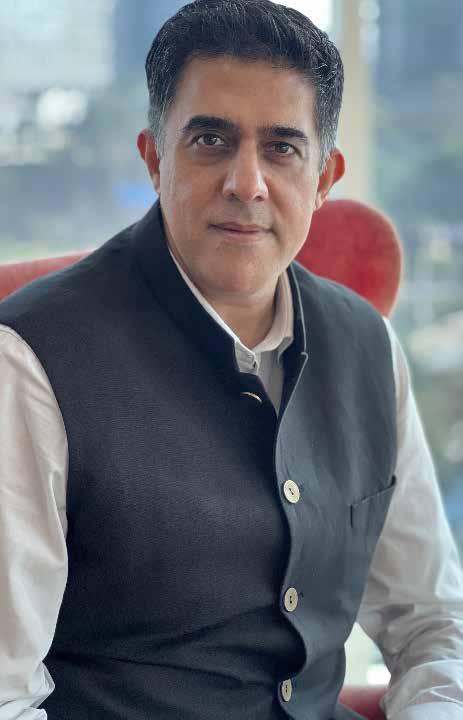
Rajan Navani Co-Chair of CII National Council on Media & Entertainment
Rajan Navani, Co-Chair of CII National Council on Media & Entertainment, President of Indian Digital Gaming Society (IDGS), Founder & CEO of JetSynthesys, shares how India’s 591 million gamers, cultural confidence, and tech-driven talent are shaping a mobile-first, globally ambitious gaming powerhouse
How would you describe the current landscape of India’s video gaming industry, and what sets it apart from other global markets? Under your leadership, “Gaming for Good” is getting traction…
India has evolved into a truly mass-market, mobile-first video gaming nation. With around 591 million video gamers, we boast one of the largest user bases globally, coupled with some of the highest data consumption rates—driven by affordable smartphones and fast, accessible networks. This scale and accessibility set India apart. The rapid growth of the sector is also translating into signifi-
cant employment opportunities across game development, design, engineering, content creation, and esports management—making video gaming not just a cultural force but a viable and expanding economic contributor.
“Gaming for Good” reflects the idea that video games can do more than entertain—they can educate, include, and inspire. Encouragingly, the government’s AVGC-XR (Animation, Visual Effects, Video Gaming, Comics & Extended Reality) Task Force has highlighted the importance of education, skills, and public-interest gaming applications. The ecosystem is increasingly aligning with this vision.
What are the top growth drivers and challenges you foresee for video gaming in India over the next five years?
I would say there are three standout drivers: (1) Connectivity: 5G and FWA (Fixed Wireless Access) are spreading quality internet to more towns; (2) Demographics: a young, creator-led audience discovering new genres every month; and (3) Momentum: most outlooks expect steady growth through the decade, with India’s games market projected to keep expanding on the back of in-app purchases and advertising.
As for challenges, we need deeper monetization models, better discoverability of Indian video gaming IP, and a stronger pool of tech-art and engineering talent. We’re already addressing the talent gap with initiatives like the Indian Institute of Creative Technologies (IICT), which will offer 17 AVGC-XR courses this year, aimed at creating job-ready professionals.
There has been a spurt of localized content and culturally resonant games shaping player engagement and industry innovation in India? (Example: real cricket.)
Real Cricket is a perfect example. We tapped into India’s biggest passion, treated it authentically with official team and player tie-ups, and built a community that plays, watches, and now even competes on broadcast. This league model illustrates how an Indian idea can scale while staying rooted in culture. This is the model I believe in: start local, get the craft right, and empower the ecosystem—players, creators, and leagues—to carry it forward.
With esports gaining popularity, how do you envision the future of organized competitive gaming, and what unique opportunities does it offer for India’s youth?
The formal recognition of esports in India marked a significant milestone. It provided legitimacy, gave aspiring players a clear path, and reassured parents. We now anticipate structured calendars, city-based franchises, and academy-style
training. With e-cricket through the Global e-Cricket Premier League (GEPL), we’re demonstrating how strong fandom, robust broadcasting, and professional formats can unlock opportunities—not just for players, but also for coaches, analysts, production crews, and event managers. It’s the convergence of sport and technology.
What role do skill development and specialized education play in building a sustainable talent pipeline for India’s game developers, designers, and artists?
It’s foundational. The Media & Entertainment Skills Council (MESC) has defined clear Qualification Packs (QPs) and National Occupational Standards. There are currently 108 Qualification Packs (QPs) designed to certify individuals for specific job roles within the media and entertainment industry. Each QP includes a National Vocational Educational Qualification Framework (NVEQF) level ranging from 1 to 10, which theoretically enables the development of competencybased training for every entry-level position in this sector.
The Qualification Packs (QPs) establish a project-based learning and assessment model for higher education in AVGCXR, akin to the formats used by NID and NIFT, by obtaining exemptions from UGC norms. This model is also adopted for AVGC-XR education outside of India.
The IICT plans to implement a curriculum based on the NIFT/NID framework, ensuring that colleges equip students with the necessary skills and that learners grasp industry expectations. The objective is to bridge the gap between academia and the industry. This hands-on, standards-based approach is essential for developing a job-ready talent pool.
How is the industry addressing the current shortage of game engineers, backend developers, and other specialized roles, and what steps are being taken to bridge the skill gap?
We’re addressing the skill gap in India’s video gaming industry through a focused three-pronged approach. First, we’re aligning academic curricula with MESC standards, enabling students to gain practical knowledge in engines, tools,
tech art, and live-ops. Second, dedicated institutions like the Indian Institute of Creative Technologies (IICT) are introducing multi-track programs tailored specifically to video gaming disciplines. Third, we’re strengthening the studio–campus connection through internships, game jams, and capstone projects—ensuring that students don’t just build portfolios but graduate with actual shipped builds. It’s a practical, industry-aligned solution that’s already in motion.
As the sector expands into tier-2 and tier-3 cities, what impact do you see on job creation, regional growth, and inclusivity within the Indian gaming ecosystem?
This is India’s superpower. A majority of our gamers now come from beyond the metros, and women gamers are a fast-growing cohort. As connectivity improves, including 5G and Fixed Wireless Access, you’ll see more creator collectives, testing hubs, shout-casting studios, and events outside the big cities. That spreads opportunity and brings new stories and languages into mainstream gaming.
A majority of our gamers now come from beyond the metros, and women gamers are a fastgrowing cohort. As connectivity improves, including 5G and Fixed Wireless Access, you’ll see more creator collectives, testing hubs, shoutcasting studios, and events outside the big cities
How are emerging technologies like AI, AR/VR, and cloud gaming changing the way games are designed, produced, and experienced by Indian gamers?
AI is quietly transforming the video gaming landscape—streamlining everything from asset creation and quality assurance to intelligent live-ops management. Cloud gaming is removing hardware barriers, enabling instant access to games without downloads, and expanding reach across diverse user segments. As locally developed content grows, AR and VR technologies are poised to gain greater relevance, especially in delivering immersive, culturally rooted storytelling. Backed by the IndiaAI Mission, which aims to strengthen the country’s AI infrastructure and research ecosystem, Indian developers now have the tools to build richer, more accessible, and globally competitive video gaming experiences.
What policy or regulatory reforms would most effectively accelerate the growth of India’s video gaming and mobile gaming industry, and how can industry-government partnerships advance this goal?
Two simple priorities. First, operationalize the National AVGC-XR Mission with a clear toolkit: incentives for original game IP, export support, and scaled skilling. Second, keep industry and government at one table—through platforms like CII and IDGS—so curricula, research grants, and incubation move quickly and stay market-relevant.
Looking ahead, what would be your vision for Indian-developed video games and esports on the global stage, and how can India establish itself as a true gaming hub for the world?
Our edge is cultural confidence plus engineering discipline. I see Indian IP— like our cricket ecosystem—travelling globally because it feels authentic and plays world-class. Esports will follow the same path: formats designed in India, broadcast at scale, and exportable to any cricket-loving market. The mantra stays the same—create in India, for India, for the world, and back it with talent, partnerships, and patient capital.
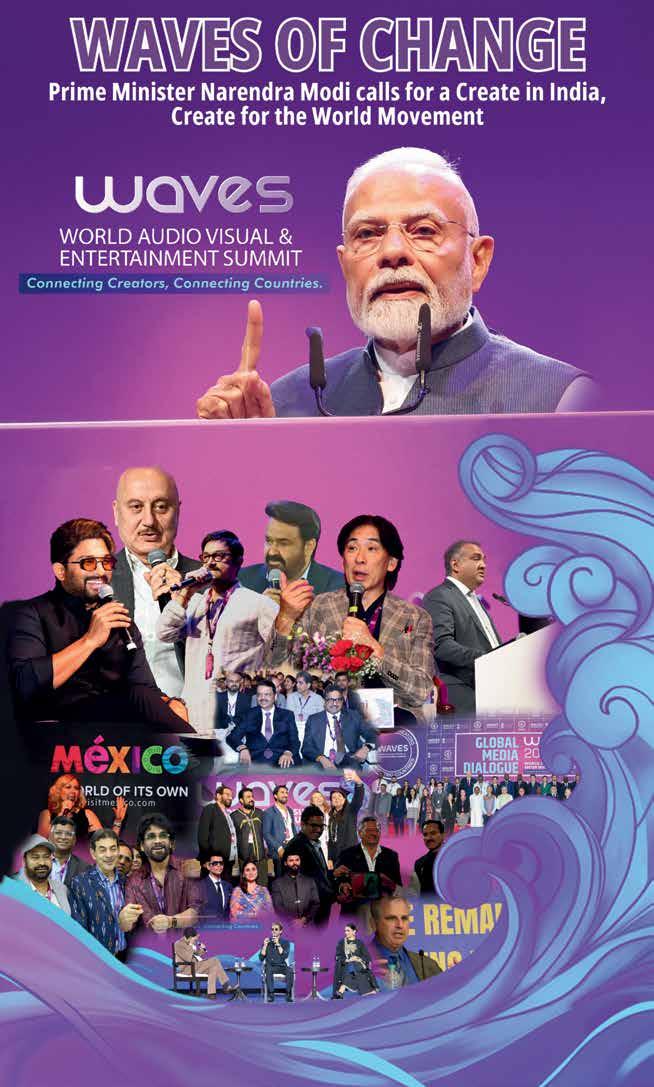





From billion-rupee business deals and crossborder collaborations to grassroots innovation and global policy shifts, WAVES 2025 proved that India’s creative surge is unstoppable — and the world is taking notice
When the curtains fell on the inaugural World Audio Visual and Entertainment Summit (WAVES 2025) in Mumbai, it wasn’t just the end of a four-day event — it felt like the beginning of a cultural and economic tide set to sweep across the world.
The significance of the event was underlined by the Ministry of Information & Broadcasting in the WAVES Outcome Report and WAVEX Outcome Report released in July, 2025, documenting the summit’s achievements, investments, and global partnerships — a tangible record of how the first edition set the tone for India’s creative economy in the years ahead.
With more than Rs 1,328 crore in business deals, 3,000+ B2B meetings, landmark policy announcements, and an unprecedented gathering of global creative forces, WAVES firmly planted India’s flag as a rising powerhouse in the media and entertainment (M&E) industry.
From film icons to tech giants, startup innovators to policymakers, the summit was a melting pot where creativity met commerce — and the chemistry was electric.
The summit began with Prime Minister Narendra Modi setting the tone at the glittering inauguration in the Jio World Convention Centre. His message was both a call to action and a declaration of intent: WAVES, he said, was more than an acronym — it was a wave of culture, creativity, and universal connectivity. He envisioned India as a global creative hub, urging the youth to tell the “one billion untold stories” of India and heralding the dawn of the nation’s Orange Economy.
Over the next four days, WAVES 2025 became a crucible of ideas, hosting 140+ sessions, 100+ international speakers, and packed auditoriums. The conference track brought together a star-studded roster of voices, from Mukesh Ambani and Ted Sarandos to Shah Rukh Khan and Deepika Padukone, dissecting everything from AI in filmmaking to the economics of streaming.
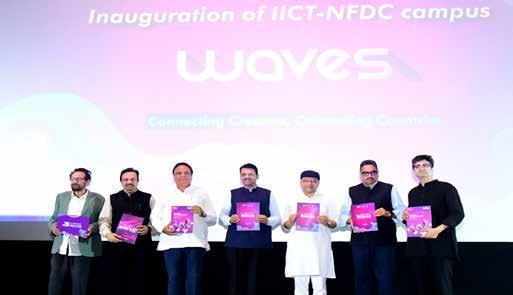
Masterclasses were a particular hit — Aamir Khan on acting, Farhan Akhtar on direction, and Michael Lehmann on filmmaking were more than talks; they were immersive lessons in craft. The breakout sessions delved deep into specialised domains like gaming, OTT, and virtual production, creating crosssector dialogues that are set to influence strategy for years to come.
While the knowledge sessions sparked ideas, WAVES Bazaar turned them into business. In its very first outing, it recorded Rs 1,328 crore worth of deals, with the Maharashtra government adding its weight through MoUs worth Rs 8,000 crore in the M&E sector.
The Bazaar was a hotbed of global collaboration: from the Prime Video & CJ ENM multi-year Korean content partnership to the first-ever Indian Film Festival in New Zealand, and Indo-UK co-productions like Devi Chowdhurani. These weren’t just contracts; they were cultural bridges.
One of the summit’s most significant outcomes was the adoption of the WAVES Declaration at the Global Media Dialogue by 77 nations. The document underscored the role of
media in promoting peace, bridging the digital divide, and celebrating diversity. Leaders like Dr. S. Jaishankar and Ashwini Vaishnaw called for a synergy of tradition and technology, with special focus on skilling and empowering creators.
If the creative economy needs fresh fuel, WAVES provided it in the form of WAVEX, the start-up accelerator for the M&E sector. Out of 1,000+ applications, 30 promising ventures pitched to heavyweight investors like Lumikai and Jio, with Rs 50 crore in investments already in the pipeline. The start-up pavilion buzzed with prototypes, ideas, and raw talent from across Tier-1 and Tier-2 cities — proof that the next big disruption in media could come from anywhere.
Policy and investment may drive the present, but data drives the future. WAVES saw the release of five key reports, including BCG’s “From Content to Commerce”, which projects India’s creator economy to influence over $1 trillion in spending by 2030, and Ernst & Young’s “A Studio Called India”, envisioning the nation as a global content hub with a 40–60% cost advantage in animation and VFX.
WITH MORE THAN RS 1,328 CRORE IN BUSINESS DEALS, 3,000+ B2B MEETINGS, LANDMARK POLICY ANNOUNCEMENTS, AND AN UNPRECEDENTED GATHERING OF GLOBAL CREATIVE FORCES, WAVES FIRMLY PLANTED INDIA’S FLAG AS A RISING POWERHOUSE IN THE MEDIA AND ENTERTAINMENT (M&E) INDUSTRY
These insights, paired with legal frameworks and live events industry analysis, give the sector a roadmap grounded in evidence and opportunity.
One of the most ambitious announcements was the launch of the Indian Institute of Creative Technology (IICT) in Mumbai — a national centre of excellence dedicated to the AVGC-XR sector. With partnerships from JioStar, Adobe, Meta, Microsoft, and NVIDIA, IICT aims to become for creative industries what IITs and IIMs are for technology and management.
The Create in India Challenge (CIC) was perhaps the most human and heart-stirring element of WAVES. With one lakh participants from over 60 countries, the competition spanned 32 challenges in animation, gaming, AI, filmmaking, and more. The youngest finalist was 12, the oldest 66, and the diversity — across geography, gender, and medium — was staggering.
The finalists showcased their innovations at Creatosphere, a vibrant zone where tradition met technology, and where grassroots innovation shared the stage with cutting-edge generative AI.
No less impactful was the Bharat Pavilion, themed From Kala to Code, tracing India’s storytelling from oral traditions to AR, VR, and immersive experiences. It wasn’t just an exhibit — it was a declaration that India’s cultural depth is not a relic of the past, but a foundation for future creativity.
From the 8th National Community Radio Sammelan honouring 12 outstanding stations, to the crosscultural deals signed in the WAVES Bazaar, to the international commitments in the WAVES Declaration — every strand of the summit’s tapestry pointed to the same truth: India is not just participating in the global creative economy, it’s shaping it.
WAVES 2025 ended with the promise of more — more collaboration, more innovation, and more opportunities for creators. As Union Minister Ashwini Vaishnaw put it during the CIC awards, “The journey has just begun.”
And if the first edition is anything to go by, that journey will be nothing short of transformative — for India, and for the world.

IICT opens in Mumbai, blending global tech partnerships and industryled courses to make India a world leader in animation, gaming, VFX, and XR, with IIT-level ambition for creative talent
In a landmark move to position India as a global hub for creative technologies, the Ministry of Information and Broadcasting, in collaboration with FICCI and CII, has launched the Indian Institute of Creative Technology (IICT)—the country’s first National Centre of Excellence dedicated to the AVGC-XR (Animation, Visual Effects, Gaming, Comics, and Extended Reality) sector. The announcement, made by Union Minister for Information & Broadcasting, Railways, Electronics and IT, Ashwini Vaishnaw at the WAVES 2025 Summit in Mumbai, was followed by the formal inauguration of IICT’s first campus at the NFDC
“PM MODI’S DREAM WAS TO HAVE AN INSTITUTION OF THE SCALE OF IITS AND IIMS IN THE FIELD OF CREATIVE TECHNOLOGIES. WE ARE FOLLOWING THAT SAME TEMPLATE TO MAKE IICT A WORLD-CLASS INSTITUTION.”
Ashwini Vaishnaw, Union Minister for Information & Broadcasting, Railways, Electronics and IT
Complex, jointly with Maharashtra Chief Minister Devendra Fadnavis. The campus houses administrative offices, classrooms, and training facilities, with a second, purpose-built campus planned at Film City, Mumbai, on land provided by the Maharashtra government.
Calling the launch a “completely novel initiative in the world of film and entertainment,” Vaishnaw said: “PM Modi’s dream was to have an institution of the scale of IITs and IIMs in the field of creative technologies. We are following that same template to make IICT a world-class institution. By equipping the creative economy with new skills, tools, and global best practices, we will incubate ideas and technologies made in India, for the world.”
With a budget allocation of ₹400 crore, IICT aims to train its first cohort of 300 students starting August 2025, alongside advanced programmes for working professionals. Courses will be industry-aligned, covering VFX, post-production, XR, gaming, and animation.
IICT has forged an impressive network of global and domestic partners, including Google, YouTube, Adobe,
Meta, Microsoft, NVIDIA, Apple, WPP, and JioStar. These collaborations will support curriculum design, internships, scholarships, incubation facilities, and placements. A landmark MoU with the University of York, UK, paves the way for joint research, faculty exchange, and internationally recognised certifications.
Building further momentum, IICT has signed agreements with Comic Con India—to provide students with industry exposure through showcases, hackathons, and IP development— and with Green Rain Studios, India’s first Unreal Authorized Training Center, to deliver cutting-edge skills in real-time technology, virtual production, and immersive media.
The inaugural academic portfolio features 17 specialised programmes: four in post-production (6–28 weeks), nine in animation, comics, and XR (6 weeks–1 year), and four in gaming (3 months–1 year). The curriculum has been designed with top industry players to match global standards while reflecting India’s creative potential.
IICT CEO Vishwas Deoskar described the vision as “making India a global powerhouse in the AVGC-XR sector by nurturing world-class talent.” A detailed curriculum will be released later this month.
IICT’s Governing Board includes senior figures from government and industry: Sanjay Jaju, Vikas Kharge, Swati Mhase, Chandrajit Banerjee, Ashish Kulkarni, Manvendra Shukul, and Rajan Navani. The Governing Council features Munjal Shroff, Chaitanya Chichlikar, Biren Ghose, Bhupendra Kainthola, and Gaurav Banerjee.
Speaking on the institute’s strategic importance, I&B Secretary Sanjay
“THE
AVGC-XR SECTOR IS ONE OF THE FASTESTGROWING SEGMENTS OF THE CREATIVE ECONOMY. IICT IS NOT JUST ABOUT PRODUCING SKILLED GRADUATES— IT’S ABOUT BUILDING AN INNOVATION ENGINE THAT WILL FEED INDIA’S LEADERSHIP IN IMMERSIVE AND DIGITAL CONTENT FOR DECADES TO COME.”
Jaju said: “The AVGC-XR sector is one of the fastest-growing segments of the creative economy. IICT is not just about producing skilled graduates— it’s about building an innovation engine that will feed India’s leadership in immersive and digital content for decades to come.”
The launch of IICT comes at a time when the global AVGC-XR market is expanding at an unprecedented pace, with immersive media, gaming, and animation driving new waves of economic opportunity. India’s vast talent base, coupled with the government’s vision and industry partnerships, positions the country to claim a significant share of this growth.
As Vaishnaw concluded at the inaugural event: “India can take the global lead in media and entertainment. IICT will be the crucible where talent meets technology, and ideas turn into worldclass creative output.”
With admissions now open and industry partnerships in full swing, IICT’s journey from a bold vision to a national creative powerhouse has officially begun—setting the stage for India’s next big leap in the digital age.
India’s next big export isn’t steel or software—it’s stories. If we protect our IP and back our creators, our culture can power our economy. By Anup Chandrasekharan

Anup Chandrasekharan
COO - Regional IN10 Media
The proposed 50 percent tariff hike by the US is not just a trade policy shift. It is a red flag for economies like India to rethink what truly powers growth. In a world where goods are becoming costlier to move, stories, ideas, and IP do not need shipping lanes. They need strategy. The creative economy is no longer just soft power. It is economic muscle waiting to be flexed.
India’s media and entertainment sector, valued at over Rs 2.3 lakh crore and expected to cross Rs 2.8 lakh crore by 2025, spans film,
television, digital, music, gaming, and live events. It is one of India’s fastest growing industries, but one of the least activated as a trade and economic lever. As traditional exports face headwinds, our stories can become new age exports, delivering both cultural influence and hard revenue.
For years, India has been a consumer of international formats, from reality shows to animation. It is time to reverse the flow. With the right policy support and creator incubation, Indian producers can develop content built to travel, rooted in our culture but crafted for the world. When a show like Delhi Crime wins an International Emmy, or RRR lights up global box offices and fan forums, it is not a one off. It is proof that our IP, if empowered, can compete on the world stage. This is not about borrowing global ideas. It is about exporting Indian originality.
But this momentum is undermined every day by a persistent threat: piracy. According to ‘The Rob Report’ released by EY and the Internet and Mobile Association of India (IAMAI) in October 2024, the size of India’s piracy economy was Rs 22,400 crore in 2023 with losses incurred from movie theaters to the tune of Rs 13,700 crore and Rs 8,700 crore from OTT platforms.
Reports from 2025, such as one by MUSO, indicate India was the second-largest source of online piracy globally in 2024, hinting at potentially increasing losses. However, exact figures for 2025 are not yet available.
According to the ‘Impact of Piracy on India’s Online Video Sector’ report, released by CII
COLLECTIVE ALIGNMENT, WE CAN MAKE THE CREATIVE ECONOMY NOT JUST OUR CULTURAL VOICE, BUT OUR TRADE BALANCER, JOB ENGINE,
in collaboration with IP House and Media Partners Asia, piracy could cost India’s digital video sector US$2.4 billion and 158M users by 2029 if we fail to take any action against it.
Films are leaked within hours, OTT originals are stripped and redistributed, and music circulates freely outside formal channels. This is not just content theft. It is economic leakage. Piracy erodes tax collections, jobs, investor confidence, and studio sustainability. A national anti piracy task force backed by strong enforcement and tech enabled content protection must be a priority if we are serious about building a monetisable creative economy.
Alongside this, we must scale up swadeshi storytelling. Regional OTT platforms, vernacular creators, and grassroots formats are surging, but still operating without a national growth framework. We need to support these creators with targeted funding, language-based distribution infrastructure, and creator first monetisation models. A Malayalam thriller or a Manipuri folklore series should not be boxed in as niche. These are not side stories. They are tomorrow’s export pipeline if we build the system today.
Equally crucial is the talent behind the scenes. India has no shortage of creative ambition, but we lack enough trained editors, animators, VFX specialists, sound designers,
and scriptwriters. Skill development must become central and outcome oriented. At the same time, we should embrace AI tools that streamline dubbing, editing, and post production, making Indian studios faster, more cost effective, and globally competitive.
On the policy front, ease of doing creative business still needs serious attention. Whether it is filming permissions, event licenses, or international co-productions, India must move toward a frictionless single window ecosystem. We already have the landscapes, talent, and ambition. What we need is clarity, consistency, and speed.
Finally, we must start measuring what matters. Without real data on jobs created, IP exported, or revenue generated, the creative economy remains under represented in policymaking. A Creative Economy Dashboard updated quarterly could drive both visibility and accountability, helping the sector secure the attention it deserves.
This is India’s moment to turn IP into GDP. To shift from being a content consumer to a global content powerhouse. With bold leadership, smarter regulation, and collective alignment, we can make the creative economy not just our cultural voice, but our trade balancer, job engine, and strategic advantage in a shifting global order.
(The views expressed are personal)
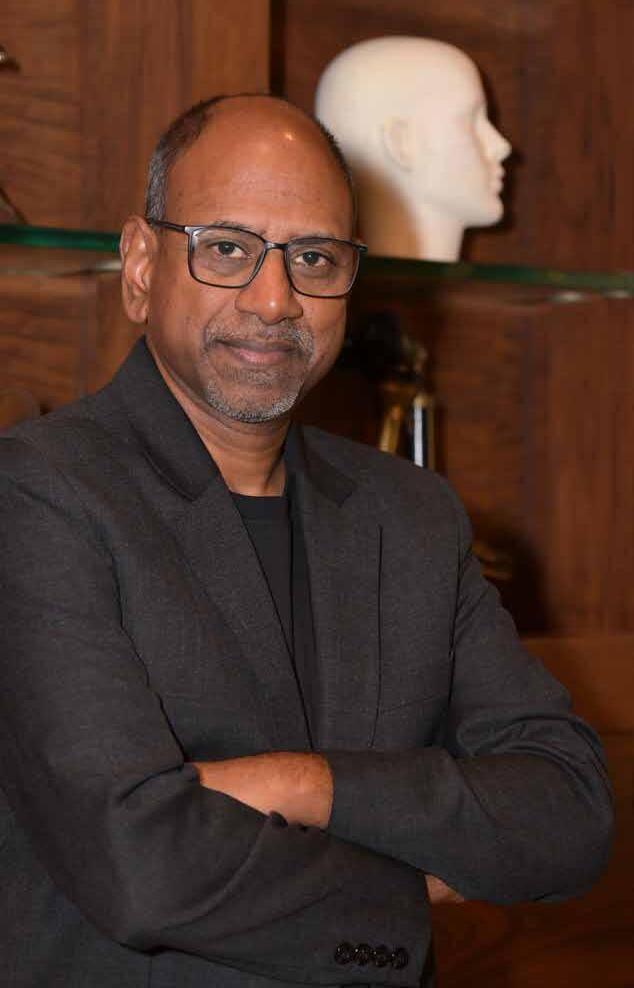
TALK OF THE TOWN
BidVid, an AI-powered bid engine built in India, delivers up to 50% efficiency gains for YouTube advertisers—saving money, boosting performance, and working seamlessly within existing campaigns
In a digital ad market, which is getting increasingly noisy and costly, a silent revolution is taking place—not in Silicon Valley, but right here in the nerve center of India: Mumbai. It is called BidVid—an AI-MLpowered bid optimization tool, which is the brainchild of Rajkumar Remalli, a media professional who spent the entire last year developing a product aimed squarely at a sole goal: increasing the efficiency of YouTube advertising.
And it has already started delivering.
At its very core, BidVid is an automated bid engine. Plug it into your YouTube campaign—particularly through Google DV360—and it begins optimizing bids in real time. Thus, you can say goodbye to changes in media plans, restructuring of campaigns, and sharing of sensitive data.
BidVid operates directly on your handle, using real-time impression data to adjust bids dynamically, which is not based on historical assumptions but actual, live campaign performance. The result? Advertisers can surely expect 20% or more in media cost savings, with many of them experiencing up to 50–70% gains in terms of efficiency.
“In testing across categories such as FMCG and entertainment, we have seen campaign performance jump drastically—and fast,” says Rohit Onkar, Independent Director at BidVid. “You can plug it in today and see results within 24-48 hours.”
There is no cloak-and-dagger here. BidVid does not store your data in any format or manipulate your unique campaign strategy. It merely makes what you already possess work harder. Think of it as a tuning chip for your car—only this one is for your media spend.
“We work well within the boundaries of the Google ecosystem,” says Rajkumar. “We’re here to help brands make the most of the tools they’re already using.”
The platform’s radical and dynamic waterfall model finetunes bids based on impressions—constantly recalibrating against KPIs such as CPM, reach, and frequency, thereby ensuring that you are not overpaying for an underperforming inventory.
Rajkumar Remalli’s resumé reads precisely like a blueprint for building a startup in the media-tech space. With senior roles in The Times of India, Hindustan Times, NDTV Media, and OpenX representation in India under his belt, he has spent decades studying and analyzing the inefficiencies in the ways brands buy media.
“Advertisers, especially in India, are under pressure to do more with less,” Rajkumar says. “BidVid was born out of that need—it’s not just a product; it’s a rethink of how programmatic should work.”
Developed exclusively in India, BidVid is steadily gaining traction globally, with early adopters in the Middle East, Southeast Asia, and Europe. The product is steadily supported by a distinguished array of media specialists who comprehend local nuances and help brands optimize continually.
BIDVIDIS
Upen Singh will cover the Middle Eastern hubs such as Dubai and Saudi Arabia.
Drawn by BidVid’s potential to redefine digital advertising, Rohit joins forces with Rajkumar Remalli as Strategic Advisor on the leadership team. His proven expertise in partnerships, market expansion, and innovation will play a pivotal role in BidVid’s next phase of growth.
With over three decades of leadership across telecom, media, and technology, Rohit Adya has driven growth and transformation at Vodafone India, Reliance Communications, and many reputed organizations.
YouTube continues to remain one of the most potent advertising platforms in the world, but it is quite easy to burn through budgets with suboptimal bidding. BidVid offers a quiet, algorithmic edge—a backend boost that ensures every rupee, dollar, or euro delivers more.
“In some cases,” says Rajkumar, “we’ve seen brands get the same results for Rs.60 that used to cost them Rs.100. And they didn’t need to rebuild a thing.”
In an era marked by an increase in ad costs, shrinkage in attention spans, and an increase in competition, tools such as BidVid are not merely helpful—they are essential and indispensable. BIDVID OFFERS A QUIET, ALGORITHMIC EDGE—A BACKEND BOOST THAT ENSURES EVERY RUPEE, DOLLAR, OR EURO DELIVERS MORE
For instance, Jon de la Mothe has been appointed as BidVid’s representative in North America and Canada, while


Astra Studios emerges from Technicolor India’s shutdown, redefining VFX with an “ArtistFirst, AI-Ready” approach. This innovative studio blends human creativity and AI, aiming to revolutionize content creation
For over a decade, Technicolor India stood as the undisputed leader in providing visual effects, animation, and CG for film, TV, games, and advertising. Across the creative technology landscape, it was the veritable engine room of imagination and scale that powered some of the world’s most iconic and award-winning content.
This year, the global parent company was brought down by overwhelming headquarters-driven overheads and international financial pressures—culminating in a bankruptcy process

governed by the French administrative system. Through all these cycles, Technicolor India, its crown jewel, remained profitable, productive, and deeply respected across global media circles.
It was in the face of this sudden and disorienting global collapse that a group of leaders from Technicolor India—its creative visionaries, strategic minds, and technological pioneers—chose not just to be overwhelmed by the storm but to chart a bold new course.
The result: Astra Studios, an enterprise built to innovate new ways to produce content on the same world-class foundations but redesigned for the future—more agile, more intelligent, and unmistakably Indian at its core.
Founded by four former senior executives from Technicolor India’s shuttered empire—Biren Ghose, RK Chand, Rajarajan Ramakrishnan, and Shajy Thomas—and backed by Hombale Group (the powerhouse behind KGF, Salaar, and Kantara) along with Perpetual Capital, Astra

Biren Ghose, CEO
As the former head of Technicolor India who witnessed first-hand both the company’s capabilities and ultimate failure, Biren Ghose brings unique insights into what the next generation of content studios must look like.
“We intend to be different from the large-scale content ‘factories’ by being more boutique and applying the intuitive logic of design-led innovation,” he explains. “Our clean slate starting position allows us to design bespoke creative systems, blending human artistry with AI intelligence in real time.”
His vision extends beyond traditional VFX work: “We’re developing bespoke GenAI tools, artist-led design, and co-creating workflows to evolve how new age content is imagined and produced.”
Studios represents more than just another VFX house rising from corporate ruins.
It’s a bold bet that the future of content creation lies at the intersection of human artistry and artificial intelligence. The Bengaluru-headquartered Astra Studios has begun operation with 100+ techs and artists in Whitefield. “We’re not just rebuilding. We’re redefining what excellence looks like in a post-AI, multi-platform, multi-format content world,” said Biren Ghose, Founder & CEO of Astra Studios.
What are
from this story? What direction is the content production industry taking? How will technologies in the production of VFX be altered?
The meltdown of companies in animation and VFX shutdown isn’t merely about corporate restructuring—it is symptomatic of deeper industry challenges. Global VFX demand has contracted 10% in 2024, with production volumes falling 24% in the Americas, 7% in EMEA, and 15% in APAC.
In the global context there has been a perfect storm: the post-Covid saturation due to overproduction with platforms began
RATHER THAN SIMPLY RECREATING WHAT EXISTED BEFORE, THE FOUNDING TEAM HAS DESIGNED WHAT THEY CALL A “CONTENT STUDIO FIRST” APPROACH THAT TREATS AI NOT AS A THREAT, BUT AS A CREATIVE AMPLIFIER
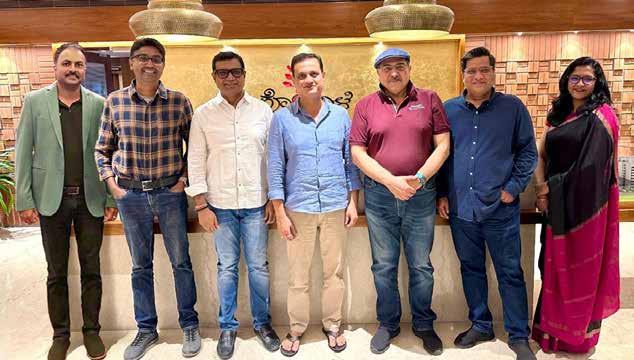
pulling back due to audience fatigue and underperforming titles; the streamers are ending the era of “subscriber growth at all costs” and in the quest for ROI are greenlighting less content with stricter budgets; and the recovery from the Hollywood disruptions has been slow, with layoffs and consolidation still underway.
“We didn’t want to go back. We wanted to go beyond,” says RK Chand, one of Astra’s co-founders and a longtime champion of India’s animation ecosystem. “So we designed a studio from scratch—one that’s lean, scalable, and obsessed with high design & quality,” he summarized.
What sets Astra Studios apart from typical post-collapse start-ups is both its timing and its philosophy. Rather than simply recreating what existed before, the founding team has designed what they call a “content studio first” approach that treats AI not as a threat, but as a creative amplifier.
“Astra is radically different—not just in how we produce, but in why we exist. We’re designing a studio built for what’s next, where creative talent and intelligent tools co-evolve,” explains Biren Ghose. “The
core of Astra is its “Artist-First, AI-Ready” philosophy.”
This isn’t just marketing rhetoric. The studio’s core focus areas represent a fundamental rethinking of content production:
End-to-End Creative Solutions: From ideation through post-production, integrating GenAI throughout the pipeline
Original IP Development: Character universes designed to live across formats—films, games, immersive media
Immersive Experiences: AR/VR and location-based media that extend beyond traditional screens
Premium Animation: Both streaming and theatrical content built with AI-assisted workflows
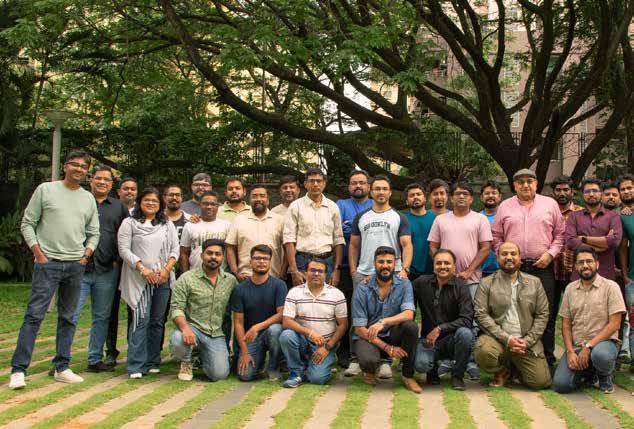
The backing from Hombale Group represents more than financial support—it’s a strategic alliance that addresses one of the Indian content industry’s greatest challenges: the transition from service provider to IP creator. Hombale, which has invested Rs.3,000 crore over five years in developing pan-India content franchises, brings proven expertise in building culturally rooted stories with global appeal.
“We are supporting the vision behind Astra Studios to help grow stories and movie franchises across different platforms using emerging technologies,” says Vijay Kiragandur, Hombale Films founder. “This will enable the Hombale Group to undertake projects with greater scope and complexity to create powerful new ‘storyworlds’ for our franchise fandoms.”
The partnership addresses what Chand, also Astra’s Chief Business Officer,
identifies as a critical market shift: “We’re witnessing a major shift where technology is democratizing content creationGenAI platforms are enabling creators to produce high-quality visuals, characters, and scenes, free from the constraints of traditional pipelines..”
What makes Astra’s approach genuinely innovative is its integration of AI throughout the creative pipeline, not just in post-production. Shajy Thomas explains their philosophy: “We follow a principle of ‘technology in the service of storytelling’.’ That means before onboarding any cutting-edge tool, we evaluate its creative impact, its integration risk, security, and its potential to scale across teams and projects.”
The studio’s technology stack represents a fundamental shift from the rigid, hierarchical pipelines that characterized megastudios like the brands at Technicolor. Instead, they’re building what Shajy Thomas calls “a next-gen content pipeline
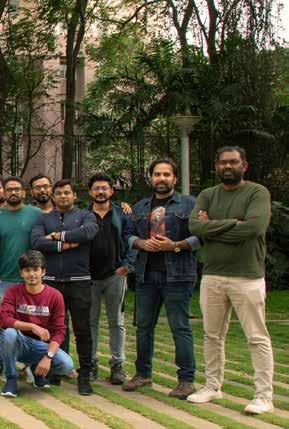
that is agile, intelligent, and format-agnostic” that combines:
Smart studio workflows with AI integration
Real-time engines for immediate iteration
Modular, API-driven ecosystems
Cloud-native, scalable infrastructure
This technical foundation enables what Rajarajan Ramakrishnan, the Chief Creative Officer, describes as “format-fluid and culturally rich” storytelling—narratives that can move seamlessly “between screens, platforms, and experiences.”
The broader implications of Astra’s approach extend far beyond one studio’s success. As Chand notes, the democratization of content creation tools is enabling “a new wave of direct-to-consumer (DTC) creators, indie filmmakers, and start-ups to build, launch, and monetize content faster than ever—across not just film or TV, but immersive XR, interactive web series, and digital experiences.”
This shift addresses one of the Indian
content industry’s persistent challenges: moving beyond service-based execution to IP ownership and global distribution. With India’s media and entertainment sector valued at Rs.2.5 trillion but generating only $2.1 billion from its 551 million OTT users—well below market potential—the opportunity for new approaches is substantial.
The timing is particularly significant given the state of the global VFX industry. Established players like Framestore, Industrial Light & Magic, and Weta FX are facing their own challenges, creating an opening for studios that can combine cost efficiency with creative innovation.

RK Chand, Chief Business Officer
With deep experience in global client relationships, Chand sees Astra’s opportunity in the convergence of technology democratization and market expansion.
“Global clients want more than output — they want collaboration, context, and co-creation. Astra is here to be a strategic ally, not just a vendor,” he emphasizes.
His approach to IP development reflects this collaborative philosophy: “Our IP strategy combines rapid prototyping with real-time engines, AIpowered world-building, and virtual art departments. We focus on original concepts that can live across formats — films, games, immersive media, and web-based experiences.”
The involvement of Perpetual Capital represents a different kind of backing than traditional VFX studios typically receiveRather than being funded by media conglomerates or private equity focused on quick returns, Astra benefits from investors who understand long-term value creation in emerging markets.

Rajarajan Ramakrishnan, Chief Creative Officer
As the creative leader, Ramakrishnan addresses the industry’s biggest concern: how to maintain artistic integrity in an AI-driven world.
“I firmly believe the creative eye and aesthetic sensibility will remain paramount, even as GenAI and ML tools revolutionize our craft. These technologies are extraordinary amplifiers of creativity, but they lack the soul, intent, and nuanced perspective that human artists bring,” he states.
His vision for the future is both pragmatic and inspirational: “GenAI and ML are like the ultimate paintbrush—capable of incredible feats but only as impactful as the hand wielding it. The creative eye and aesthetic sensibility will always be the guiding force, shaping raw technology into art that inspires, challenges, and moves.”
This financial structure enables what the founders describe as patient capital with a belief in the development of IP, creating a new generation of talent and tech. As Thomas notes, “The goal is never to chase tech trends but to integrate tools that genuinely serve the creative vision and improve the production process.”
The emergence of Astra Studios comes at a critical moment for India’s animation and VFX industry. The sector, which saw revenues decline 14% in 2024 due to global disruptions, needs new models that can weather industry volatility while capitalizing on India’s talent advantages.
“India is at an inflection point in the global content arena, and Astra aims to lead that evolution, creating new jobs while continuing to partner with creatives globally,” Biren Ghose emphasizes.
This ambition responds to the broader industry criticism that India’s content sector is still trapped in a service-provider mentality. As one industry analysis noted: “For Indian VFX and digital design firms, the way forward is not just service-based execution. The future lies in owning IPs and digital assets—creating original content instead of always executing for others.”
Like the most successful start-up stories chronicled in the pink pages, Astra’s emergence reflects broader technological and economic shifts that create opportunities for nimble, well-funded challengers to disrupt established industries.
WHAT MAKES ASTRA’S APPROACH GENUINELY INNOVATIVE IS ITS INTEGRATION OF AI THROUGHOUT
The studio’s approach mirrors successful tech company pivots: taking established expertise, applying emerging technologies, and targeting underserved market segments. In this case, the underserved market segment is the growing demand for AI-integrated content creation, which traditional studios have been slow to address.
The founders’ backgrounds provide credibility—they know intimately both what worked and what failed at one of the industry’s largest players. Their investor backing provides the resources to build something genuinely different rather than simply recreating the past.
Most importantly, their timing aligns with fundamental industry shifts: the democratization of content creation tools, the global expansion of streaming platforms, and the emergence of AI as a creative amplifier rather than a replacement.
As Astra Studios begins operations, it faces the challenge of delivering on ambitious promises while navigating an industry still reeling from recent disruptions. The founders’ confidence reflects both their extensive experience and their conviction that they’ve identified a genuine market opportunity.
“The takeaway from our meeting was that they just did not want to recognize what was ‘normal!’ They are hands and knees into the next—not wanting to just hire back talent, but to amplify it,” notes one industry observer.
Their ambition extends beyond simply creating successful projects: “At Astra, narrative and technology don’t just coexist—they co-compose. From AI-assisted pipelines to design-led worldbuilding, we want to add value to stories that shall move minds and markets,” said Ghose.
Whether Astra Studios can deliver on these grand ambitions remains to be seen. But in an industry desperately seeking new models for sustainable, creative, and technologically sophisticated content creation, their emergence represents exactly the kind of bold reimagining that economic disruptions often catalyze.

Shajy Thomas, Chief Technology Officer
Shajy Thomas brings the technical expertise to realize these ambitious visions, focusing on building systems that can scale with both artistic ambition and technological capability.
“Our pipelines shall be built to flex, adapt, and empower — not just for today’s demands, but for the media ecosystems emerging around us,” he explains.
His approach emphasizes modularity and intelligence: “The infrastructure for content production is rapidly evolving toward hybrid, scalable, and intelligent systems, combining cloud-native workflows, real-time engines, and AI-assisted automation.”
The collapse of Technicolor marked the end of an era. The rise of Astra Studios—and similar studios—may well mark the beginning of the next era in content creation.
As one founder put it, “The stars are my compass, and the future is my destination”—he was probably looking upwards at the Astra Universe!
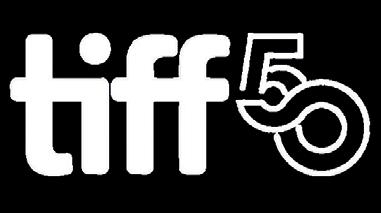

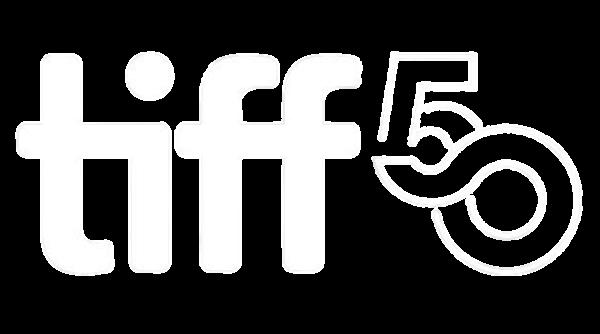


For 50 years, TIFF has united audiences, filmmakers, and Oscar glory like no other festival. In its golden year, it honours a legacy of cinematic discovery while building a new future as the hub for buying, selling, and celebrating stories on every screen
The Toronto International Film Festival (TIFF), which prepares to roll out its 50th edition in September 2025, bears testimony to the transformative power of film and the ability of a single annual showcase of the best of world and Canadian cinema to reshape the medium’s global landscape. From its humble beginnings as the “Festival of Festivals” in 1976, TIFF has evolved into one of the most influential launchpads in North America for films seeking to generate international buzz. Not surprisingly, it is today one of the world’s most prestigious cultural institutions.
The numbers speak volumes about TIFF’s power to prophesy Academy Awards glory. In the 25 years since 1999, as many as six to ten films that won TIFF’s People’s Choice Award, or figured among the runners-up, went on to claim the Academy Award for Best Picture: American Beauty (1999), Slumdog Millionaire (2008), The King’s Speech (2010), Argo (2012), 12 Years a Slave (2013), Spotlight (2015), Green Book (2018), Parasite (2019), Nomadland (2020), and Anora (2024).
Add to those figures the number of films on the TIFF People’s Choice Awards list that have won the Oscar for Best Foreign Language Feature Film (now renamed Best International Feature Film), and you have a track record that is impossible to beat. Way back in 1985, the Argentine film The Official Story, directed by Luis Puenzo, won the TIFF People’s Choice prize and the Academy Award for the Best Foreign Language Film.

Since then, seven other entries—Pedro Almodovar’s Women on the Verge of a Nervous Breakdown, Marleen Gorris’ Antonia, Roberto Benigni’s Life is Beautiful, Ang Lee’s Crouching Tiger, Hidden Dragon, Tsotsi, Asghar Farhadi’s A Separation, and Alfonso Cuaron’s Roma—have repeated the feat, cementing the festival’s reputation as an awards season crystal ball.
The astonishing strike rate has transformed TIFF’s People’s Choice Award into what industry insiders call the “starting gun” of the Academy Award nominations race. The festival’s influence extends far beyond just the top prize—films screened at Toronto collectively garner more Academy Award nominations than those from all other major festivals combined. TIFF People’s Choice Award winners and runners-up have scored a remarkable 20 Best Picture Academy Award nominations in the last decade alone.
The festival’s Oscar prediction prowess stems from its unique positioning in the awards season calendar. Perfectly timed in early September, TIFF serves as the crucial bridge between summer film completion and the intensive awards campaigning season. As Variety noted, the festival allows films to “generate early buzz” at exactly the right moment to capture Academy voters’ attention.
Notable TIFF-to-Oscar success stories include Chariots of Fire (1981), which launched this predictive tradition, followed by modern masterpieces like The Big Chill (1983), Leaving Las Vegas (1995), Life Is Beautiful (1998), Crouching Tiger, Hidden Dragon (2000), and Silver Linings Playbook (2012). The festival’s Platform Award, established in 2015, has also proven prescient, with Barry Jenkins’ Moonlight winning both the Platform Prize at TIFF 2016 and the Academy Award for Best Picture.
Cameron Bailey CEO, TIFF

TIFF’s status as North America’s premier film festival is unquestioned in industry circles. With over 700,000 annual attendees and more than $114 million in economic impact, it dwarfs all other North American festivals in both scale and influence. The festival ranks consistently among the international “Big Five” alongside Cannes, Venice, Berlin, and Sundance.
What distinguishes TIFF from its European counterparts is the access that it grants the filmgoing public. Unlike the exclusive, industry-focused nature of Cannes or the more limited Venice screenings, TIFF presents itself as “the world’s largest publicly attended film festival”. This democratic approach creates a unique environment where genuine audience enthusiasm—not just industry politics—drives film discovery and success.
The festival’s programming breadth is staggering: approximately 400 films from around the globe screen across more than 30 venues throughout downtown Toronto. This massive scope allows TIFF to showcase everything from Hollywood biggies to emerging international cinema, creating what programmers describe as “something for everyone”—a philosophy dating back to the festival’s inception.
Industry professionals recognise Toronto’s distinct advantages. As one festival regular (any name?) noted: “TIFF is actually about the movies, selling them to distributors, and generating Oscar buzz. It offers the advantage of being in the Anglosphere, so it lends itself more towards getting press. It is also by far the most publicfriendly festival, so films can get buzz from actual moviegoers.”
Since joining TIFF in 1990 and ascending to the CEO’s position in 2021, Cameron Bailey has emerged as one of the most influential figures in contemporary cinema. Born in London to Barbadian parents and raised across England, Barbados, and Canada, Bailey brings a uniquely global perspective that has shaped TIFF’s international reach and cultural inclusivity.
Bailey’s impact on the film industry extends far beyond festival programming. As the architect of TIFF’s modern identity, he has fundamentally reshaped how films reach global audiences. His foundational work includes creating the Planet Africa section in 1995, which provided crucial visibility for African and diaspora cinema, and developing the Perspective Canada programme that championed domestic filmmakers.
Under Bailey’s leadership, TIFF has evolved from primarily a film exhibition
TIFF’S PEOPLE’S CHOICE AWARD INTO WHAT INDUSTRY INSIDERS CALL THE “STARTING GUN” OF THE ACADEMY AWARD NOMINATIONS RACE
platform into a comprehensive cultural institution with year-round programming, educational initiatives, and industry development programmes. His strategic vision positions TIFF not merely as a festival but as a “permanent destination for film culture”.
Bailey’s industry recognition is substantial: Toronto Life magazine named him one of “Toronto’s 50 Most Influential People” for 13 consecutive years (2012-2024). He holds membership in the Academy of Motion Picture Arts and Sciences and was honoured as a Chevalier in France’s Order of Arts and Letters. His influence extends globally through jury service at major festivals, including Cannes, Venice, and Berlin, and speaking engagements at institutions from Harvard University to the Smithsonian.
Perhaps most significantly, Bailey has steered TIFF through unprecedented challenges while maintaining its artistic integrity and global relevance. During the COVID-19 pandemic and Hollywood strikes, his leadership ensured the festival’s continuity and resilience. As he approaches TIFF’s 50th anniversary, Bailey is simultaneously looking backward to honour the festival’s legacy while pioneering its future through an ambitious 2026 content market launch.
The relationship between Indian cinema and TIFF has evolved from occasional showcasing to a robust, strategic partnership. The festival’s curation of Indian films has expanded in scope and depth over the decades, starting with the programming of Satyajit Ray’s Shatranj Ke Khilari in one of TIFF’s early years.



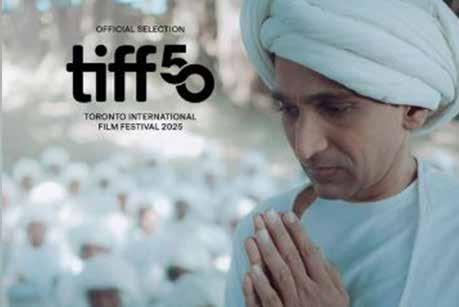
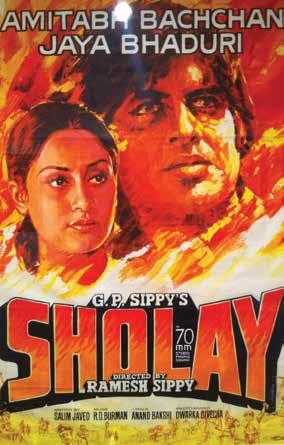

Recent years have demonstrated Indian films’ growing prominence at Toronto. The 2023 edition proved particularly significant, with three Indian films claiming major awards. Tarsem Singh Dhandwar’s Dear Jassi won the prestigious Platform Award, while Jayant Somalkar’s Marathi film A Match claimed the NETPAC Award, and Nikhil Nagesh Bhat’s Kill secured first runner-up in the Midnight Madness section.
The 2025 festival continues this momentum with four confirmed Indian selections: Neeraj Ghaywan’s Homebound, Anurag Kashyap’s Monkey in a Cage, Bikas Mishra’s Bayaan, debutant Jitank Singh Gurjar’s In Search of the Sky, Hansal Mehta’s upcoming web series Gandhi (in Primetime, which steps into its tenth year), and a special 50th anniversary restoration of Ramesh Sippy’s iconic Sholay. Notably, Homebound features Martin Scorsese as an executive producer, signalling significant international confidence in Indian storytelling.
Earlier triumphs include notable People’s Choice Award winners, such as Pan Nalin’s Angry Indian Goddesses (first runner-up in 2015). In 2018, Vasan Bala’s Mard Ko Dard Nahi Hota won the Midnight Madness People’s Choice Award. That apart, Lijo Jose Pellissery’s Jallikattu was selected for TIFF’s landmark “50 Films That Shaped Its Legacy” series. The festival has also showcased restored Indian classics, including the 2024 special screening of Raj Kapoor’s 1951 masterpiece Awara to commemorate the legendary filmmaker’s centenary.
In 2001, the Indian film Maya, directed by Digvijay Singh, won the People’s Choice first runner-up award, relegating Mira Nair’s Venice Golden Lion-winning Monsoon Wedding to the second runner-up spot. The very next year, British-Indian director Gurinder Chadha’s Bend It Like Beckham was the People’s Choice Award second runner-up. Mira Nair was back in the mix in 2016 with Queen of Katwe, an American sports drama set in a slum in Kampala, Uganda.
This growing Indian presence reflects TIFF’s broader commitment to international cinema, with Anita Lee, the Chief Programming Officer at TIFF, noting that global audiences, particularly younger demographics, show “ever greater interest in international films.”
To commemorate its 50th anniversary, TIFF curated “The TIFF Story in 50 Films”, a definitive collection showcasing the movies that shaped both the festival and global cinema. This prestigious selection demonstrates the breadth and quality of films that have defined TIFF’s curatorial excellence over five decades.
The collection spans decades, genres, and continents, featuring landmark achievements from international cinema. Notable selections include:
• Asian Cinema Masterpieces: Hirokazu Kore-eda’s After Life, Edward Yang’s A Brighter Summer Day, Bong Joon Ho’s Memories of Murder, and Hayao Miyazaki’s The Boy and the Heron.
• North American Classics: Paul Thomas Anderson’s Boogie Nights, Steven Spielberg’s The Fabelmans, Frank Darabont’s The Shawshank Redemption, and Rob Reiner’s The Princess Bride.
• International Discoveries: Pedro Almodóvar’s Matador, Denis Villeneuve’s Maelström, Vishal Bhardwaj’s Maqbool, and Deepa Mehta’s Water.
• Contemporary Breakthroughs: Coralie Fargeat’s Revenge, Rose Glass’s Saint Maud, and Lijo Jose Pellissery’s Jallikattu.
This collection represents more than mere programming history—it chronicles TIFF’s role in introducing global audiences to cinema that matters. As Cameron Bailey explains, “These 50 films tell the story of our festival’s obsessions, discoveries, and lasting influence. At the heart of it: those moments when TIFF’s curation met the Toronto audience and the world found a new movie to fall in love with.”
Beyond the anniversary collection, TIFF has premiered countless other significant films throughout its history. The festival served as the launching platform for eventual Best Picture winners, including 12 Years a Slave, Slumdog Millionaire, The King’s Speech, and American Beauty. Platform
Award winners like Moonlight and Sound of Metal went on to achieve both critical acclaim and Academy recognition.
As TIFF celebrates its golden anniversary, the organisation is simultaneously engineering its most ambitious expansion since the construction of TIFF Lightbox. The launch of TIFF: The Market in September 2026 represents a transformational leap that could reshape the global film industry’s commercial ecosystem.
This unprecedented initiative, supported by a landmark $23 million CAD investment from the Canadian federal government, will establish Toronto as North America’s premier hub for buying and selling screenbased content across all platforms. Unlike traditional film markets, TIFF: The Market will encompass film, television, interactive content, and immersive experiences, reflecting the industry’s convergence across media formats.
Cameron Bailey’s vision for the market is expansive: “We plan to grow the power of screen storytellers by bringing dealmakers, talent, and audiences together in a new, much bigger way.” The initiative aims to


more than double TIFF’s current industry attendance from approximately 5,000 to over 12,000 professionals within five years.
The market’s strategic timing positions it perfectly within the global festival calendar. Running September 10-16, 2026, it will operate concurrently with the 51st TIFF festival, creating synergies between artistic presentation and commercial activity that mirror successful European models like Cannes’ Marché du Film and Berlin’s European Film Market.
Industry leadership for the market includes a prestigious Global Advisory Committee featuring powerhouse executives: former Cannes Film Market head Jérôme Paillard, Sony Pictures Classics co-founder Michael Barker, MUBI’s Arianna Bocco, BBC Studios’ Janet Brown, and Lucasfilm’s Vicki Dobbs Beck, among others. This high-
profile backing signals serious industry commitment to Toronto’s market ambitions.
The market’s broader implications extend beyond commerce. As Anita Lee explains, it represents TIFF’s evolution “to become a global event, where creative industries intersect across art, entertainment, and new experiences”. This vision aligns with industry trends toward platform-agnostic content creation and distribution.
Looking toward its next half-century, TIFF’s trajectory reflects both continuity and innovation. The 50th anniversary celebrations throughout 2025 will honour the festival’s legacy while positioning it for future growth. Bailey’s leadership emphasises sustainability, global reach, and cultural impact: “We are one of the great events in this city, one of the great events in this country, a cultural event that brings the attention of the world to Canada.”
The festival’s commitment to Canadian talent remains paramount, with Bailey noting a surge in Indigenous filmmaking supported by organisations like the Indigenous Screen Office, which saw an “unprecedented 15 Indigenous titles” programmed at TIFF 2024. This dedication to domestic artists complements the festival’s international expansion, creating a model for cultural institutions worldwide.
TIFF’s future also embraces technological evolution and changing audience behaviour. The introduction of
the International People’s Choice Award in 2025 reflects growing global audience engagement with international cinema. Meanwhile, year-round programming initiatives and digital platforms extend the festival’s reach beyond its traditional September footprint.
As TIFF approaches its golden anniversary, it has mutated into something more than a film festival—it represents a democratic cultural institution that has democratized access to global cinema while maintaining the highest artistic standards. From its origins as a modest showcase for international films to its current status as the world’s most influential film discovery platform, TIFF’s five-decade journey reflects the transformative power of visionary leadership, curatorial excellence, and unwavering commitment to the art of cinema.
The festival’s legacy extends far beyond awards predictions or industry statistics. TIFF has fundamentally altered how films reach audiences, how careers are launched, and how global stories find their way into local hearts. As Cameron Bailey noted in curating the 50th anniversary film collection, these are “those moments when TIFF’s curation met the Toronto audience and the world found a new movie to fall in love with”.
In an industry marked by constant disruption and technological upheaval, TIFF’s enduring success demonstrates that authentic passion for cinema, combined with strategic vision and community engagement, creates lasting cultural impact. As the festival prepares to launch its revolutionary market initiative and enter its second half-century, it does so not as a relic of cinema’s past, but as an architect of its future.




Honoring
CII Purbo Bharat Summit celebrated a century of legendary filmmakers with eyes fixed on the future of India’s creative economy
In a time of swift digital evolution, where contemporary storytelling is reshaping the film industry, the heritage of Indian cinema trailblazers remains a source of inspiration for countless filmmakers and movie enthusiasts. The CII Purbo Bharat Big Picture Summit 2025 made a significant move in honouring and preserving a rich legacy by recognising five iconic figures who have profoundly influenced the Indian film industry—Ritwik Ghatak, Salil Chowdhury, Tapan Sinha, Guru Dutt, and Raj Kapoor. Family members of these legends were invited to accept the honour that recognises their lasting contributions, which will continue to illuminate the creative economy of Purbo Bharat. A short film highlighting their work was also played at the event.
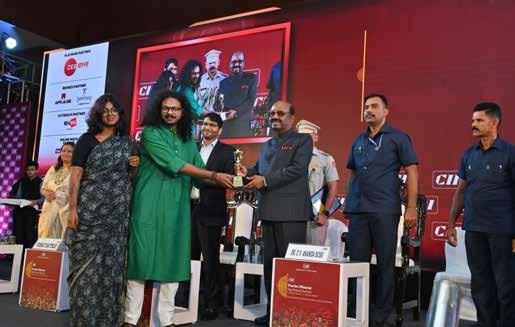
Tapan Sinha’s films were a celebration of humanism, morality, and compassion. Drawing inspiration from global cinema while staying deeply rooted in Indian ethos, his films like Kabuliwala (1957), Hatey Bazarey (1967), and Safed Haathi (1977) exemplified storytelling that resonated across generations. His ability to capture the nuances of everyday life earned him immense respect and accolades.
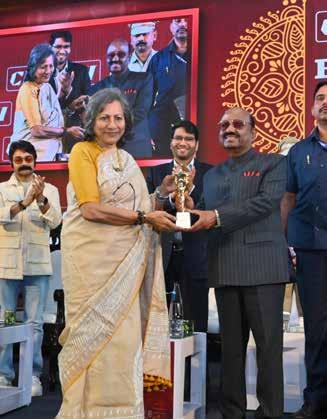
The undisputed ‘Showman of Indian Cinema,’ Raj Kapoor was an actor, producer, and director who captivated audiences with his blend of romance, social themes, and iconic music. Films like Awara (1951), Shree 420 (1955), and Mera Naam Joker (1970) transcended national borders, making him a beloved figure in global cinema. His legacy continues to shape Bollywood’s storytelling style.
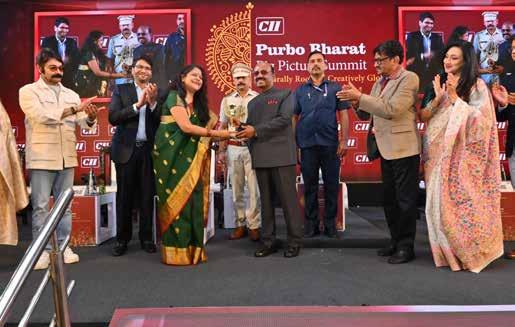
A composer, poet, and screenwriter, Salil Chowdhury was a visionary who seamlessly blended Indian classical music with Western symphonies. His compositions in films like Madhumati (1958), Anand (1971), and Rajnigandha (1974) became timeless, capturing the emotional depth of Indian storytelling. Beyond Bollywood, his contribution to Bengali and Malayalam cinema remains unparalleled.
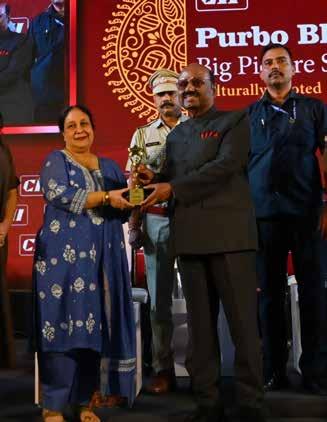
A visionary director, actor, and producer, Guru Dutt’s films were an exquisite blend of artistic brilliance and deep introspection. His masterpieces Pyaasa (1957) and Kaagaz Ke Phool (1959) explored existential dilemmas with unparalleled visual storytelling. Despite his tragically short life, his influence on cinematic craft, particularly in framing and lighting, remains legendary.
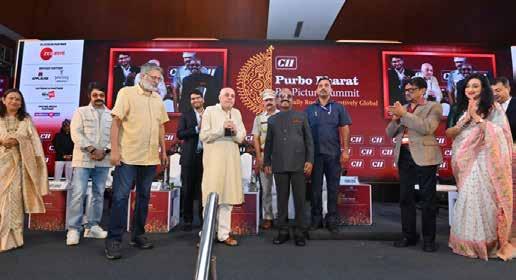
Ritwik Ghatak’s cinema was deeply embedded in the socio-political realities of his time. Known for his stark portrayal of partition’s aftermath and its impact on human lives, his films like Meghe Dhaka Tara (1960), Komal Gandhar (1961), and Subarnarekha (1962) remain masterpieces of realism. His work, infused with haunting music and poetic imagery, continues to influence filmmakers exploring themes of displacement and resilience
The centenary tribute at the CII Purbo Bharat Big Picture Summit 2025 featured commemorative discussions, panel sessions, and film screenings. The presence of the families of these luminaries added emotional depth to the occasion, as they shared personal anecdotes and insights into the creative genius of their forebears.
“The timeless contributions of these cinematic legends continue to guide the industry,” said Goutam Ghose, acclaimed filmmaker and Summit Co-chair. “Their stories, struggles, and artistry are as relevant today as they were decades ago.”
The tribute not only reflected on the artistic heritage left behind but also served as a source of inspiration for emerging filmmakers. As Purbo Bharat’s creative economy expands, the lessons drawn from these maestros will be instrumental in shaping its future.
By integrating the wisdom of the past with the tools of the future, the Indian entertainment industry is poised for an era of global excellence. As Purbo Bharat celebrated a century of cinematic brilliance, the CII Purbo Bharat Big Picture Summit 2025 stood as a bridge between legacy and innovation, ensuring that the spirit of these legends continues to inspire storytellers for generations to come.



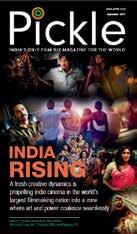

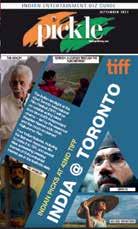

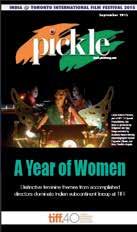








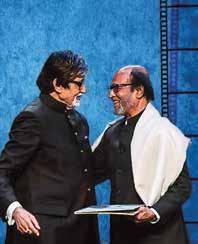
















Pickle







www.pickle.co.in







